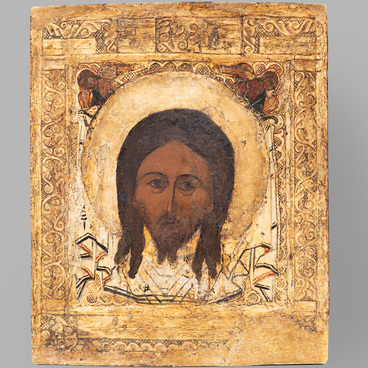This icon came to the Murmansk Regional Art Museum from Saint Nicholas Church — an architectural monument of federal significance in the village of Kovda, Murmansk Region. The church was built on the site of the destroyed temple in 1705.
The temple complex, created at the turn of the 18th century, arrests the visitor’s attention with its amazing proportionality that matches the surrounding landscape. The wooden church of the “klet” type stands in the old part of Kovda on a hill and seems to be crowning the old Pomor village.
After the temple was closed in 1960, some of the icons were transferred to the State Russian Museum and the Museum of Fine Arts of the Republic of Karelia. The rest of the icons remained in a closed building for more than 30 years, until they were transferred in a state of disrepair for restoration, and then entered the Murmansk Regional Art Museum.
The iconography of Saint Sergius of Radonezh dates back to the beginning of the 15th century: the cover from the holy relics of Saint Sergius, located in the Sergiev Posad State Museum-Reserve is considered to be one of the oldest images. One of the first scenes from the saint’s life was his prayer to the Holy Trinity, which is also reflected in the composition: the Old Testament Trinity is depicted in the clouds above Saint Sergius of Radonezh. The image extends beyond the frame and is carefully added to the top field of the icon. There is almost no lower field, and there are traces of a later saw cut along the lower edge.
Saint Sergius (1314–1392) was a miracle worker who greatly influenced the spiritual history of the Russian state. The saint founded the Holy Trinity Monastery near Moscow and the theological school of Russian monasticism.
The icon is a canonical image of the saint — he was painted from the front point of view, in full length, and with a scroll in his hand. His figure is flanked by four scenes from his life.
Traditionally, the scenes in an Orthodox icon follow clockwise starting from the top left corner. In this case, the chronology of the scenes starts in the bottom left corner followed by the top left, the centerpiece, and then the top right and bottom right corners.
The temple complex, created at the turn of the 18th century, arrests the visitor’s attention with its amazing proportionality that matches the surrounding landscape. The wooden church of the “klet” type stands in the old part of Kovda on a hill and seems to be crowning the old Pomor village.
After the temple was closed in 1960, some of the icons were transferred to the State Russian Museum and the Museum of Fine Arts of the Republic of Karelia. The rest of the icons remained in a closed building for more than 30 years, until they were transferred in a state of disrepair for restoration, and then entered the Murmansk Regional Art Museum.
The iconography of Saint Sergius of Radonezh dates back to the beginning of the 15th century: the cover from the holy relics of Saint Sergius, located in the Sergiev Posad State Museum-Reserve is considered to be one of the oldest images. One of the first scenes from the saint’s life was his prayer to the Holy Trinity, which is also reflected in the composition: the Old Testament Trinity is depicted in the clouds above Saint Sergius of Radonezh. The image extends beyond the frame and is carefully added to the top field of the icon. There is almost no lower field, and there are traces of a later saw cut along the lower edge.
Saint Sergius (1314–1392) was a miracle worker who greatly influenced the spiritual history of the Russian state. The saint founded the Holy Trinity Monastery near Moscow and the theological school of Russian monasticism.
The icon is a canonical image of the saint — he was painted from the front point of view, in full length, and with a scroll in his hand. His figure is flanked by four scenes from his life.
Traditionally, the scenes in an Orthodox icon follow clockwise starting from the top left corner. In this case, the chronology of the scenes starts in the bottom left corner followed by the top left, the centerpiece, and then the top right and bottom right corners.



